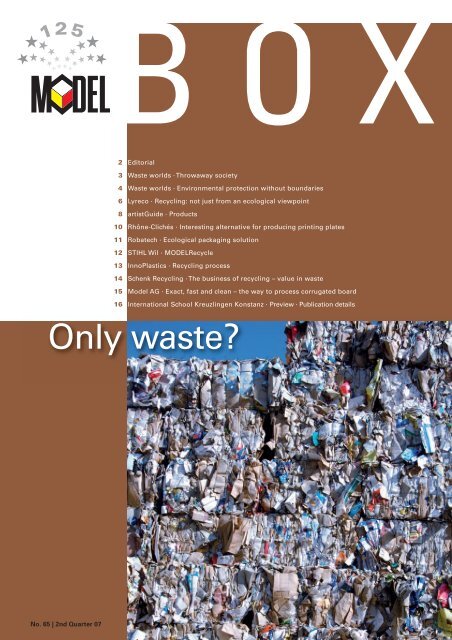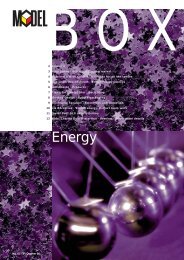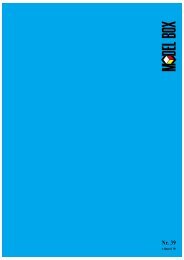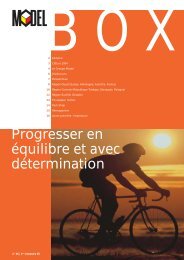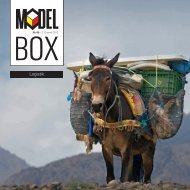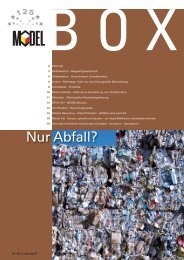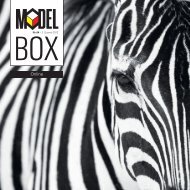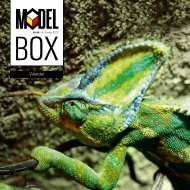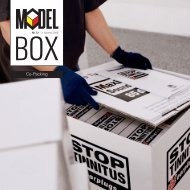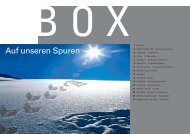Only waste? - Model Holding AG
Only waste? - Model Holding AG
Only waste? - Model Holding AG
- TAGS
- www.modelgroup.com
You also want an ePaper? Increase the reach of your titles
YUMPU automatically turns print PDFs into web optimized ePapers that Google loves.
No. 65 | 2nd Quarter 07<br />
BOX<br />
2<br />
3<br />
4<br />
6<br />
8<br />
10<br />
11<br />
12<br />
13<br />
14<br />
15<br />
16<br />
Editorial<br />
Waste worlds · Throwaway society<br />
Waste worlds · Environmental protection without boundaries<br />
Lyreco · Recycling: not just from an ecological viewpoint<br />
artistGuide · Products<br />
Rhône-Clichés · Interesting alternative for producing printing plates<br />
Robatech · Ecological packaging solution<br />
STIHL Wil · MODELRecycle<br />
InnoPlastics · Recycling process<br />
Schenk Recycling · The business of recycling – value in <strong>waste</strong><br />
<strong>Model</strong> <strong>AG</strong> · Exact, fast and clean – the way to process corrugated board<br />
International School Kreuzlingen Konstanz · Preview · Publication details<br />
<strong>Only</strong> <strong>waste</strong>?
EDITORIAL<br />
2<br />
Valuable <strong>waste</strong>?<br />
Almost all the goods we consume end up as<br />
<strong>waste</strong>. Precisely for this reason, western consumer<br />
societies with their huge consumption<br />
of goods attach great importance to reliable,<br />
clean <strong>waste</strong> disposal.<br />
In this respect, Switzerland’ has a commendable<br />
record. Whereas in the 1980s and 1990s<br />
<strong>waste</strong> disposal was a major source of environmental<br />
pollution and a nuisance for many of<br />
our country’s inhabitants, since then Switzerland<br />
has made considerable progress. Although<br />
success in cutting consumption of raw<br />
materials by producing more efficient and<br />
longer-lasting goods is still the exception, government<br />
regulations have drastically reduced<br />
the concentration of harmful substances in<br />
many products. All plastics, for instance, now<br />
have to be cadmium-free.<br />
In the past 20 years the increase in the amount<br />
of <strong>waste</strong> produced has been contained by separate<br />
collection of different <strong>waste</strong> fractions.<br />
Alongside <strong>waste</strong> incineration, refuse separation<br />
is the second prong of Swiss <strong>waste</strong> management<br />
policy. Better recycling is another important<br />
measure to reduce environmental pollution;<br />
today considerably more raw materials are<br />
returned to the circular flow of goods and services.<br />
In Switzerland, the proportion of recycled<br />
<strong>waste</strong> from households and small-scale commercial<br />
operations and industry has risen from<br />
approx. 25% in 1988 to some 51% in 2005.<br />
Various factors are behind this success, including<br />
the provisions of the regulation concerning<br />
beverage containers, which threaten the introduction<br />
of a deposit on containers if minimum<br />
recycling quotas are not met. Other important<br />
factors were the introduction of voluntary collection<br />
and funding systems by business, e.g.<br />
for PET drinks bottles, cans and paper; information<br />
provided by communes, <strong>waste</strong> collection<br />
operators and business; and finally polluterbased<br />
financing, i.e. fees charged for collecting<br />
sacks of non-recyclable refuse. In the final<br />
analysis, this success depends on motivating<br />
all inhabitants to cooperate. Neighboring<br />
countries have different legal provisions, with<br />
the result that further fractions are collected<br />
separately. For instance, in contrast to statutes<br />
in neighboring countries, Swiss legislation<br />
does not solely target packaging: Switzerland<br />
does not have a general regulation governing<br />
packaging, nor is one planned. On the other<br />
hand, there are provisions that apply to specific<br />
packaging types and properties.<br />
As the quality of recyclable raw materials is<br />
currently good, they command good prices in<br />
the market for recovered materials. However,<br />
new product developments (e.g. new product<br />
labels with metal-containing semiconductor<br />
chips) can impair the quality of collected material<br />
and, in turn, upset a well-functioning system.<br />
This needs to be addressed. The aim<br />
should be to ensure that a large part of all<br />
<strong>waste</strong> flows back into the economy in the form<br />
of cleaned and sorted secondary raw materials.<br />
All of these recycling systems not only help to<br />
reduce environmental pollution – recycling often<br />
uses fewer resources than disposal and<br />
new production –, but recycling also is often<br />
considerably cheaper than disposing of <strong>waste</strong><br />
in <strong>waste</strong> incineration plants. At the same time,<br />
there is no need to recycle at all cost: «Waste<br />
should be recycled if this causes less environmental<br />
pollution than <strong>waste</strong> disposal and the<br />
corresponding new production. In addition, recycling<br />
needs to have a solid long-term economic<br />
basis.» (Mission statement of the Swiss<br />
Waste Management Industry 1986).<br />
The ban on the direct disposal of non-recoverable<br />
<strong>waste</strong> and the major improvements in<br />
<strong>waste</strong> incineration have significantly reduced<br />
environmental pollution. A modern <strong>waste</strong> incineration<br />
plant can energetically convert <strong>waste</strong><br />
into heat and power that can also be used in industrial<br />
processes in the vicinity. Waste recycling<br />
thus makes a key contribution to the sustainable<br />
use of resources. This is a sensible<br />
use of, in particular, refuse that contains compounds<br />
and contaminated and mixed <strong>waste</strong>.<br />
Furthermore, there are signs that the energetic<br />
potential of other non-recoverable fractions<br />
may soon be put to good use, especially the<br />
processing of green <strong>waste</strong>, garden trimmings<br />
and possibly wood chips to fuel. Now this<br />
would unexpectedly turn <strong>waste</strong> into a valuable<br />
asset.<br />
Dr. Hans-Peter Fahrni<br />
Federal Office for the Environment FOEN
Throwaway society<br />
The throwaway society is a phenomenon<br />
of the western industrialized countries.<br />
In economies of scarcity – as in<br />
the Third World – people re-use things<br />
over and over again out of necessity.<br />
On the other hand, one advantage of<br />
these economic conditions is the low<br />
level of <strong>waste</strong> accumulation.<br />
What do we mean by throwaway mentality?<br />
A non-sustainability-based attitude and the<br />
thoughtless disposal of litter (e.g. bottles, paper,<br />
beverage cans, etc.) in the environment, in<br />
the street or in green spaces immediately after<br />
completion of consumption.<br />
The throwaway mentality or throwaway society<br />
is underpinned by the production and consumption<br />
of increasing quantities of unnecessary,<br />
short-dated goods. Today, many high-quality<br />
and correspondingly expensive products<br />
(electronic devices being a case in point) are<br />
often also so designed that even minor defects<br />
cannot be repaired or at a cost out of all proportion<br />
to the price. Critical voices argue that the<br />
only purpose of this is to force the consumer<br />
to buy new equipment, which, in turn, produces<br />
unnecessary <strong>waste</strong>.<br />
In industrialized countries the term «refuse<br />
emergency» has entered the vocabulary. This<br />
does not describe a state of too much refuse,<br />
but the lack of places to dispose of some or all<br />
of it. It applies in particular to commercial<br />
<strong>waste</strong>. Meanwhile, in other parts of the world<br />
people are dealing with emergencies of a very<br />
different nature.<br />
Living from and with refuse<br />
For thousands of people rubbish tips such as<br />
Smoky Mountain in Manila in the Philippines<br />
are both home and a source of work and income.<br />
The inhabitants of Smoky Mountain, for<br />
instance, have in effect created functioning recycling<br />
programmes. They convert the «unwanted»<br />
<strong>waste</strong> into valuable income-generating<br />
materials. So why are the inhabitants being<br />
evacuated? In tropical countries, heavy rains<br />
regularly cause devastating landslides in rubbish<br />
tips. The rainwater also carries noxious<br />
and unsanitary substances. Moreover, the<br />
stench and fumes are injurious to the inhabitants’<br />
health. They suffer from respiratory problems,<br />
nausea, headaches and other complaints.<br />
National and international organizations<br />
are helping to draw up and implement cost-effective<br />
programmes. The goal is not only to<br />
produce less <strong>waste</strong>, but also to recycle it properly.<br />
However, the emphasis is on measures to<br />
help the inhabitants. Resettlement has deprived<br />
many of them of their source of income.<br />
Hence, they are being trained in the professional<br />
recovery of materials from <strong>waste</strong> as well<br />
as new possibilities of processing it. More than<br />
100 housewives process old newspapers and<br />
telephone books into tissues and accessories<br />
for sale in the Australian market. A line of fashionable<br />
clothing has also been established to<br />
generate additional jobs.<br />
WASTE WORLDS<br />
Even though older Smoky Mountains have<br />
been grassed over, the dangers associated<br />
with them have not yet been banished. New<br />
rubbish tips are being created. Better organization<br />
has attracted new «inhabitants». The human<br />
race continues to produce increasing<br />
quantities of <strong>waste</strong>. So, while mothers cultivate<br />
their vegetable patches on what are now<br />
«green mountains», their children play in the<br />
rainwater run-off – completely disregarding the<br />
dangers of waterborne diseases. (Source and<br />
illustrations: Asian Development Bank, Manila,<br />
Rita Festin)<br />
3
WASTE WORLDS<br />
4<br />
Environmental protection<br />
Environmental protection is a topic of<br />
discussion everywhere. However, it is<br />
not managed in the same way in all<br />
countries. The <strong>Model</strong> Group operates in<br />
various European countries and among<br />
even these there are differences. The<br />
current issue of <strong>Model</strong> Box highlights<br />
various perspectives. A short description<br />
of the situation in the Philippines<br />
will be found on Page 3. Rules and regulations<br />
are somewhat stricter in<br />
Switzerland. Particular attention is given<br />
to the refuse incineration plant in<br />
the Canton of Thurgau, as this is where<br />
the headquarters of the <strong>Model</strong> Group<br />
are located. The situation in Poland,<br />
where the problems are different again,<br />
offers another comparison.<br />
Thurgau <strong>waste</strong> incineration plant KVA<br />
Thurgau – the organization<br />
Environmental protection is a key element in<br />
the corporate culture of the KVA Thurgau Association.<br />
KVA Thurgau operates a business that<br />
is compliant with environmental legislation and<br />
regards itself as a competent, self-critical service<br />
provider in the field of environmental protection.<br />
KVA Thurgau has adopted selective<br />
measures to promote environmental aware-<br />
ness and reduce <strong>waste</strong> both within its catchment<br />
area and beyond. It employs a safe and<br />
environmentally compatible technology to dispose<br />
of residual materials. KVA Thurgau practises<br />
open dialogue to reinforce the trust of its<br />
member communes, the population, its employees<br />
and its partners.<br />
KVA Thurgau uses a quality and environmental<br />
management system to ensure that its operations<br />
are transparent at all times.<br />
The KVA Thurgau Association actively provides<br />
information and consulting to promote the<br />
avoidance, reduction and recycling of <strong>waste</strong> on<br />
the part of residential developments, commerce<br />
and industry. Unavoidable <strong>waste</strong> is collected<br />
and sorted professionally and recycled<br />
using an environmentally compatible technology<br />
and thermally disposed of and/or deposited<br />
in landfills. KVA Thurgau gives support<br />
to the member communes in all questions related<br />
to <strong>waste</strong> and coordinates the different activities<br />
among the communes and beyond the<br />
canton’s borders.<br />
Instrumental in achieving clean <strong>waste</strong> management,<br />
fifty employees work at the <strong>waste</strong> incinerator<br />
plant in Weinfelden, the RAZ Hefenhofen<br />
regional collection center and the landfills<br />
in Pfyn and Kehlhof.<br />
The Thurgau <strong>waste</strong> incineration plant entered<br />
into operation in 1997. In the good ten years<br />
since then it has provided a clean, thermal<br />
means of disposing of well over a million<br />
tonnes of <strong>waste</strong>.<br />
KVA Thurgau values Thurpapier’s<br />
competence in cardboard disposal<br />
For a number of years the KVA Thurgau Association<br />
has collaborated with Thurpapier, a <strong>Model</strong><br />
Group company, which recycles a large part of<br />
the recovered paper and cardboard <strong>waste</strong>.<br />
Dieter Nägeli, divisional head of KVA Thurgau is<br />
very satisfied: «Our cooperation functions perfectly.<br />
We are involved primarily in negotiating<br />
contracts and prices; operational matters are<br />
decided directly between the collecting partners<br />
and recyclers.»<br />
Outsourcing of recoverable paper<br />
collection<br />
In particular, local societies and schools top up<br />
their club or classroom funds by collecting<br />
<strong>waste</strong> paper and cardboard. Collection is coordinated<br />
directly with Texta <strong>AG</strong>, St. Gallen and<br />
deliveries are taken to Thurpapier. The residents<br />
of Thurgau collect some 3,600 tonnes of<br />
cardboard a year, equal to 19 kg per inhabitant.<br />
This requires well thought-out logistics. Thanks<br />
to years of cooperation, everything functions<br />
smoothly.<br />
KVA Thurgau also supplies Thurpapier fully with<br />
process steam in order to reduce the combustion<br />
of oil and gas. This results in an excellent<br />
CO2 balance.<br />
Collecting alone is not enough<br />
As Dieter Nägeli points out: «Previously, everything<br />
was <strong>waste</strong>; today it is clear that besides<br />
<strong>waste</strong> there are also recyclable materials and<br />
raw materials. As raw materials are used up,<br />
the importance of recycling is growing». As a<br />
producer of recycling articles, Thurpapier plays<br />
a big part in ensuring that the products obtained<br />
from <strong>waste</strong> are recycled for consumption.<br />
However, consumers also have to shoulder<br />
responsibility: «The cycle only functions if<br />
end users consciously buy and use as many recycled<br />
products as possible.» In other words,<br />
every one of us is called upon to make a personal<br />
contribution to environmental protection.
without boundaries<br />
Waste management in Poland<br />
Waste management policy in Poland is regulated<br />
by Polish and EU law. In other words,<br />
all EU regulations have legal force in Poland.<br />
Of the many guidelines and statutes, those<br />
relating to the following areas are the most<br />
important:<br />
1. The country’s <strong>waste</strong> management industry<br />
2. Recycling of used cars that have been dis -<br />
posed of<br />
3. Electronic goods and household appliances<br />
4. Packaging and recoverable packaging<br />
5. Waste management law<br />
6. Manufacturer’s obligation (including, among<br />
other things, product and landfill charges)<br />
7. Environmental protection<br />
8. Cleanliness in communes (the smallest,<br />
most immediate level of self-government)<br />
From 2009 onwards, in all countries (with the<br />
exception of Poland, Cyprus and Malta) the<br />
content of recycled material in packaging must<br />
be at least 55%.<br />
A selection of regulations in Poland<br />
In most cases, Poland has adapted its national<br />
ordinances to those of the EU. However,<br />
Poland has, for instance, been given a grace<br />
period until 2014 to introduce stricter regulations<br />
governing the recycling of packaging.<br />
At present, packaging has about 25% recycled<br />
content; this is forecast to rise to 36.6% in<br />
2007.<br />
Poles have to separate <strong>waste</strong>. Residents of the<br />
country are obliged to dispose of glass, metal,<br />
plastic, paper (all in segregated bags) and biological<br />
<strong>waste</strong> separately. Furthermore, all citizens<br />
have to take used consumer-goods batteries<br />
to collection points or return them to<br />
dealers or manufacturers. In certain sectors different<br />
principles of <strong>waste</strong> management apply,<br />
e.g. medicine, electronic appliances, hazardous<br />
materials, excrement, chemicals, etc.<br />
Used cars are an enormous problem. What<br />
should be done with cars that are no longer<br />
roadworthy? To date Poland has imported<br />
some two million very old cars. To impose<br />
some order, all outlets that sell more than 1000<br />
cars a year are obliged to scrap the used cars.<br />
Otherwise they have to pay a fee of about 130<br />
euros per car. The scrapping facility may not be<br />
more than 50 km from the car owner’s registered<br />
address. Facilities responsible for scrapping<br />
or breaking up cars have to recycle 85%<br />
of the car by weight, otherwise they, too, have<br />
to pay fees.<br />
Quantities of <strong>waste</strong> in Poland in 2004<br />
(in million tonnes)<br />
Total 11.802<br />
Biological <strong>waste</strong> 2.486<br />
Paper and cardboard 2.114<br />
Plastic 1.529<br />
Glass 0.889<br />
Metal 1.521<br />
Forecast quantities of <strong>waste</strong> (in million t):<br />
2014: 12.290<br />
2018: 12.962<br />
Forecast for recycling in 2007:<br />
paper and cardboard 48% (highest level)<br />
glass 40%<br />
plastic 25%<br />
Quantities of recycling in Poland in 2006<br />
compared to the EU (in million tonnes)<br />
Actual Minimum quantities<br />
quantities for recycling according<br />
2006 to the EU (in 2008)<br />
Plastic 0.070 0.1627<br />
Paper and cardboard 0.825 0.9763<br />
Glass 0.400 0.6686<br />
Based on the national regulation on <strong>waste</strong><br />
treatment<br />
5 million tonnes<br />
4<br />
3<br />
2<br />
1<br />
0<br />
1985 1990 1995 2000 2005<br />
WASTE WORLDS<br />
Quantities of <strong>waste</strong> in Switzerland in 2005<br />
(in million tonnes)<br />
Total 15.671<br />
Building <strong>waste</strong> 11.9<br />
Residential <strong>waste</strong> 4.99<br />
of which recycled: 2.41<br />
<strong>waste</strong> paper 1.24<br />
glass 0.3<br />
electrical and electronic<br />
appliances 0.0825<br />
PET bottles 0.0316<br />
Incinerated <strong>waste</strong> 3.14<br />
Incineration capacity of <strong>waste</strong> incineration<br />
plants 2005: 3.377<br />
Situation in Switzerland<br />
Recycling quotas:<br />
Glass: 96%<br />
Paper and cardboard: about 77%<br />
PET beverage bottles > 75%<br />
Total residential <strong>waste</strong> in Switzerland in 2005: 4.94 million tonnes<br />
Development in collection of separated <strong>waste</strong> and of residential <strong>waste</strong> (source: BAFU 2007)<br />
Sep. coll. 51%<br />
2.5 m t<br />
335 kg/inhab.<br />
■ Div. recycling<br />
■ Glass<br />
■ Paper<br />
■ Compost<br />
■ Residential <strong>waste</strong><br />
(2.44 m t, 327 kg/inhab.)<br />
5
LYRECO<br />
6<br />
Recycling: not just from<br />
Interview with Erwin Fries, Logistics<br />
Director, Lyreco Switzerland<br />
Founded in 1926, Lyreco <strong>AG</strong> is a B2B<br />
office supplies company with 11,000<br />
employees worldwide. The former<br />
Büro-Fürrer <strong>AG</strong> company has been part<br />
of the Lyreco Group since 2005. Its 400<br />
employees in Switzerland generate annual<br />
sales of more than CHF 162 million.<br />
Lyreco is principally concerned<br />
with bundling the flow of goods so as<br />
to simplify the purchasing of corporate<br />
office supply materials.<br />
In Switzerland, Lyreco <strong>AG</strong> operates under two<br />
brands: for office and coffee supplies under<br />
the Lyreco label, and office furniture under the<br />
Büro-Fürrer label. The company’s clientele is<br />
drawn from across the business spectrum in<br />
Switzerland. Both small firms and large companies<br />
such as UBS order goods from Lyreco. Today,<br />
online orders account for 70% of Lyreco’s<br />
sales. This corresponds to a volume of about<br />
4000 packages a day that are sent all over<br />
Switzerland. To ensure a smooth delivery service,<br />
Lyreco has to have reliable partners and<br />
suppliers – in respect not only of delivery<br />
times, but also of quality and price. Although<br />
certification still plays a subordinate role in our<br />
industry, it is becoming an increasingly prominent<br />
factor.<br />
Customers that place their orders by 5 pm will<br />
have their goods delivered personally by a<br />
driver on the next business day. To make this<br />
happen, more than 110 employees work different<br />
function-based shifts in logistics between<br />
5 am and, as a rule, about 7 pm. The logistics<br />
department divides the day into two shifts:<br />
the blue shift and the red shift.<br />
Blue shift (inbound process)<br />
In the morning the conveyor belt is used to<br />
move new supplies of goods to the storage<br />
area. Merchandise is delivered, controlled and<br />
recorded at an early hour. Then it is placed in<br />
blue-labelled reusable packaging and transported<br />
by conveyor belt to the appropriate<br />
warehousing zones for storage. This simple<br />
procedure ensures that the potential of the<br />
packaging line is optimally exploited and the<br />
«traffic volumes» of the forklift drivers are kept<br />
to a minimum.<br />
Red shift (outbound process)<br />
This afternoon shift deals with customer orders.<br />
Orders are either recorded in the central<br />
SAP ERP system or automatically integrated<br />
from the online shop and then forwarded to<br />
distribution centre control. The first step is to<br />
calculate the volume of the order and assign<br />
the correct packaging to it, which is marked<br />
red. The empty packaging in different sizes is<br />
automatically delivered by conveyor belt to the<br />
various packing stations where the corresponding<br />
articles have been sent by a paperless<br />
procedure. The final step in the packaging line<br />
is quality control. After that, the deliveries are<br />
loaded onto SBB rail wagons, which transport<br />
them to the four hubs in Switzerland (Geneva,<br />
Berne, Ticino and St.Gallen) or directly to the<br />
drivers for local distribution in the region<br />
Zurich, Aargau, Basel and Lucerne. The packages<br />
arrive at their destinations early in the<br />
morning, where they are sorted and delivered<br />
directly to customers by a fleet of trucks.<br />
Empty Lyreco packaging put out by customers<br />
is picked up by the drivers and taken back to<br />
the distribution centres. This combined railand-road<br />
concept has proved to be an optimal<br />
solution, and one that also makes a valuable<br />
contribution to environmental protection.<br />
Where did the idea of using reusable<br />
packaging come from?<br />
Lyreco has always proactively tried to translate<br />
customer needs into performance. In recent<br />
years it has become apparent that customers<br />
have grown more aware of ecological issues.<br />
Customers would also like to cut down on superfluous<br />
material. The choice of five packaging<br />
sizes meets this need. Reusable cartons<br />
also obviate the need for additional packaging<br />
for return and sample consignments. The customer<br />
simply places the returns in the reusable<br />
packaging. Approx. 50% of all dispatch packaging<br />
is sent back with our drivers and more than<br />
30% can be reused in the packaging process.
Cardboard pre-cuts<br />
produced<br />
an ecological viewpoint<br />
Raw materials<br />
procured<br />
Pre-cuts<br />
stored<br />
Waste cardboard<br />
recycled<br />
Materials required<br />
delivered to Lyreco<br />
Reusable box<br />
fed back into<br />
recycling process<br />
<strong>Model</strong>/Lyreco reusable boxes: ecological cycles<br />
Lyreco’s environmental commitment<br />
In addition to reusable packaging and the general<br />
distribution using SBB (Cargo), Lyreco took<br />
other steps to protect the environment. For instance,<br />
empty toner and inkjet cartridges, batteries,<br />
etc. can be returned free of charge for<br />
proper disposal. All <strong>waste</strong> that is collected or<br />
produced is sorted and then professionally disposed<br />
of. The product catalogue of more than<br />
480 pages is printed on 100% recycled paper.<br />
Partners as well as employees are encouraged<br />
to actively participate in this kind of environmental<br />
protection. Lyreco in Switzerland is<br />
currently working towards certification to<br />
ISO 14001.<br />
Reusable boxes<br />
returned<br />
Reusable box<br />
produced/assembled<br />
Order delivered<br />
to Lyreco’s<br />
end customer<br />
Customer order<br />
picked &<br />
prepared<br />
What about your employees? What can<br />
they expect from you?<br />
Lyreco has signed on to the Global Compact.<br />
This lays down clear principles in respect of<br />
human rights, social labour standards, environmental<br />
protection and combating corruption.<br />
These principles are regularly reiterated to<br />
employees and actively practised.<br />
Will the company need the services of a<br />
distribution centre in the future as well?<br />
Owing to the spread of globalization, internationally<br />
active customers have a growing interest<br />
in negotiating single buyer contracts for<br />
their worldwide operations. The better in-<br />
LYRECO<br />
formed we are about our customers’ needs,<br />
the better we can advise them and harmonize<br />
volumes and prices on a global basis. Certification<br />
to ISO 9001 and 14001 will further increase<br />
demands on suppliers and logistics.<br />
It remains an exciting market that is bound to<br />
offer a lot in the way of new challenges that<br />
call for new solutions.<br />
7
ARTISTGUIDE<br />
Hengstenberg Bio Display<br />
The Hengstenberg range of organic products<br />
was launched last year. Whether in bags, jars<br />
or displays, the items have a unifying, instantly<br />
recognizable label. This display presents the<br />
entire 12-product Biolinie range in a clear, wellstructured<br />
arrangement in supermarkets and<br />
department stores.<br />
Frucht-Tiger<br />
This Frucht-Tiger (fruit tiger) offers children a<br />
way to quench their thirst. The tiger surrounded<br />
by fruit is an important element of this<br />
packaging. The tiger is flexo printed on the exterior<br />
of the packaging.<br />
The thirst quencher comes in three different<br />
flavors. After opening the package, the consumer<br />
has no problem selecting his choice of<br />
flavor. This solution also has distinct advantages<br />
for dealers. It can, for instance, be transported<br />
without difficulty. At the same time, it<br />
functions as a counter display.<br />
8<br />
Products<br />
Modifast<br />
Slim is the message of<br />
this flexible solution for<br />
Modifast bottles. The<br />
laminated offset<br />
printed display has a<br />
modular construction consisting<br />
of individual trays, a base and a<br />
crowner.<br />
The individual trays are placed directly on the<br />
counter in pharmacies and drugstores. Or the<br />
base can be placed on the floor and the trays<br />
mounted on top to create an attractive, freestanding<br />
display.<br />
Wine boxes for Martel<br />
Martel, a client, required an exclusive-looking,<br />
yet robust wine packaging. A uniform design<br />
has been created for the colorful boxes with inserts<br />
for 6, 3, 2 or 1 bottle. The exterior surface<br />
is printed in two-colored offset design and subsequently<br />
laminated. The interior has a flexoprinted<br />
surface. Delivered as flat packs, the<br />
packaging is quickly converted into practical<br />
boxes that are simple to open and shut.<br />
Marlboro Travelbox<br />
Working in close cooperation with <strong>Model</strong>,<br />
Philip Morris created this distinguished packaging<br />
for «Marlboro», the most popular cigarette<br />
brand in the world. Each Travelbox is printed in<br />
red, green and gold and holds ten packets of<br />
cigarettes. Travelboxes are produced exclusively<br />
for sale in duty-free shops.<br />
The outer box is specially glued. On opening<br />
this covered packaging you discover an ingenious<br />
insert and a partition strip that ensure optimal<br />
presentation of the product. Embossing<br />
and UV gloss elegantly highlights the Marlboro<br />
logo. Hot-foil printing is used to tastefully<br />
heighten the contrast with the UV matt finish<br />
of the printed outer box.<br />
Put an end to insects<br />
In many places insects are a<br />
real pest. This counter-top display<br />
has been specially developed<br />
for the German market.<br />
Thanks to the dispenser base,<br />
the display is easy to set up. A<br />
cover placed over the display<br />
protects the «Clean Kill» set<br />
so that it can be easily transported.<br />
An eye-grabbing<br />
crowner catches shoppers’<br />
attention at the point of sale.<br />
Spritzer<br />
Still looking for a light, superior quality,<br />
palatable, low-alcohol drink for that special<br />
occasion? Each of these<br />
small bottles is filled with<br />
27.5 cl of Rimuss to satisfy<br />
the taste of the discriminating<br />
individual.<br />
The distinctive gold-andsilver<br />
design of the fivecolor<br />
flexoprinted pack<br />
containing 12 bottles<br />
has an eye-catching appeal.<br />
The printing is fully lacquered for protection.<br />
In addition to the bottles, Rimuss has introduced<br />
drinks in cans. To attract the attention of<br />
the beverage trade to this new product, the<br />
manufacturer has distributed an amusing<br />
gift pack that contains not only a can of<br />
beverage, but also a glass and a straw.<br />
Thanks to its form, content and offset<br />
laminated printing, this very elegant<br />
packaging has triggered a positive market<br />
reaction.
sia soft<br />
The packaging is intended<br />
to mirror the high-quality finish<br />
of this high-end abrasive<br />
from sia. The once<br />
brown outer wrapping has<br />
been enhanced technically as well as<br />
qualitatively. The emotional element of the design<br />
is consciously heightened. Since sia soft<br />
is used primarily in the automotive industry, the<br />
aim is to transfer people’s emotional bond with<br />
cars to this product. The clear varnish finishings<br />
show a beautiful packaging to superb<br />
advantage.<br />
The Association of Lucerne Carpenters<br />
and Joiners<br />
The Association of Lucerne Carpenters and<br />
Joiners intends to present something special at<br />
the Lucerne Trade Fair. Usually visitors stick<br />
their prospectuses in their rucksacks; this year<br />
the Association wanted an alternative means<br />
of carriage. One condition is that the<br />
customers should spend more time<br />
at the Association's stand. In addition,<br />
the giveaway article should be<br />
durable and attract attention. At the<br />
same time, the visitors should come<br />
into contact with the principal material<br />
of carpentry: wood.<br />
The result is the trolleybox, a combination<br />
of corrugated board<br />
and wood. It is not so<br />
easy to leave with a<br />
trolley as one might<br />
think; it first has to be<br />
assembled. Curiosity<br />
and the positive response<br />
of visitors have even led to<br />
waiting times at the stand.<br />
Afterwards, the trolley<br />
makes a useful container<br />
for a variety of things, for<br />
instance around the house or in a<br />
child’s room, or to distribute mail.<br />
Music stool<br />
Gifts for musicians. Music lovers will find<br />
socks, cups, erasers and other ideas for gifts at<br />
the Kübler music boutique. But there is one<br />
thing they won’t find: musical instruments.<br />
Designed especially for Kübler, the music stool<br />
can be used for decorative purposes by music<br />
stores, or to provide seating at<br />
trade fairs. And of course it can<br />
also be used as a practice stool.<br />
Thanks to its prominent motif,<br />
this idea has high advertising<br />
appeal and strikes a chord with<br />
the defined target group.<br />
HotWheels<br />
Children’s eyes light up<br />
when they catch sight of this<br />
fast racetrack. This attractive display,<br />
which <strong>Model</strong> designed is an extremely<br />
short space of time, was produced for an<br />
Easter sales campaign. The display was placed<br />
at the POS in Carrefour and Coop stores all<br />
over Switzerland. Various <strong>Model</strong> businesses<br />
were closely involved in this project. The exterior<br />
sections are litholaminated offset printed.<br />
The display was constructed in Weinfelden<br />
and assembled and stocked with the supplied<br />
products in-house.<br />
Haco Mirador display<br />
You don’t only need spices in<br />
the barbecue season. This<br />
multi-section display presents<br />
Mirador spices in luminous<br />
yellow. <strong>Model</strong> assembles<br />
and fills the ready-touse<br />
display and delivers it<br />
direct to the regional Migros<br />
warehouse. A litholaminated<br />
offset printed crowner is an<br />
additional eye-catcher.<br />
Haco Subito rice<br />
display<br />
Consumers need to be able<br />
to get these tasty<br />
rice dishes<br />
off the<br />
shelves just as<br />
fast as they can prepare<br />
them. The open display<br />
solution meets this requirement.<br />
And the additional<br />
support construction<br />
also allows for problem-free<br />
transportation.<br />
ARTISTGUIDE<br />
Toblerone display –<br />
winner of the 2006<br />
WORLDSTAR<br />
After receiving a Swiss<br />
Star last year, the Toblerone<br />
display has now<br />
capped this performance<br />
with a WorldStar.<br />
For its display Kraft Foods<br />
was looking for a solution<br />
that would allow<br />
the existing shelf trays<br />
to function as display<br />
shelves as well. In the solution<br />
developed the trays are suspended in<br />
a column at an angle so that they slant forwards.<br />
Thanks to the tilt, customers have a<br />
clear view of the entire contents and can<br />
easily extract the Toblerone triangles. The<br />
well-designed arrangement provides space<br />
for 60 400g Toblerone bars. Being on a slant,<br />
the contents automatically slide forward<br />
each time a Toblerone is removed.<br />
Every customer immediately associates the<br />
triangular display column with the famous<br />
Toblerone shape.<br />
The <strong>Model</strong> designers of the display were<br />
proud to accept the WorldStar award in May.<br />
9
RHÔNE-CLICHÉS<br />
Interesting alternative for<br />
producing printing plates<br />
10<br />
Talking to<br />
Frédéric Valz-Blin<br />
Rhône-Clichés has analyzed<br />
all of its customer<br />
orders for the corrugated<br />
board industry<br />
for a year. This study<br />
determined the percent<br />
fraction of <strong>waste</strong> for<br />
printing plates of solid<br />
photopolymer plastics.<br />
The manufacturer has<br />
searched for new methods<br />
for further development<br />
of the production<br />
process in order to<br />
shorten their production<br />
times.<br />
In parallel with this study,<br />
Rhône-Clichés requested<br />
their customers from the<br />
corrugated board processing<br />
sector to rethink and redefine<br />
their requirements for<br />
plates and their production.<br />
As a result, corrugated board<br />
processing has demanded<br />
an especially cost-effective<br />
plate which should be<br />
specifically adapted to the<br />
individual orders.<br />
Quality should satisfy the<br />
special requirements for<br />
printing corrugated board.<br />
The fact that qualitative<br />
losses in print will not be<br />
accepted in the various<br />
processes (in-line, die-cutting,<br />
off-line presses) goes without saying.<br />
The study demonstrated that those responsible<br />
for printing in the corrugated board industry<br />
expect the following of the printing plates:<br />
Plates should also enable optimum color<br />
transfer to a print substrate consisting primarily<br />
of recycled material.<br />
The plate material must be compressible<br />
enough to also smooth out or lessen the unevenness<br />
and the washboard effect in the<br />
corrugated board.<br />
Plates must be easy to mount and easy to<br />
handle.<br />
The plate material should ideally be workable<br />
in various Shore hardnesses for halftone and<br />
large-format printing on a plate.<br />
In specific cases, printing plates without adhesive<br />
films or sealing of the plate material<br />
on both sides are requested. In compact<br />
assembly, the liquid photopolymer is poured<br />
directly on the Mylar film.<br />
Goals: removal of the photopolymer material<br />
from the Mylar film and prevention of water<br />
penetrating between the film and plate<br />
material.<br />
Possibility of high-quality printing of the corrugated<br />
board without crushing its height due<br />
to the printing pressure and support pressure.<br />
An express production process, in case of<br />
misprints on the printing press.<br />
High stability.<br />
We have performed studies together with our<br />
customers, also including <strong>Model</strong> Emballages,<br />
and have decided on the production of plates<br />
from the newest generation of liquid photopolymer.<br />
We will then equip these plates<br />
with all of the technical refinements.<br />
What are the technical advantages of liquid<br />
photopolymer?<br />
The most important quality advantages of the<br />
liquid photopolymer are reasonable costs, flexible<br />
production, good print quality and high environmental<br />
compatibility.<br />
Why have you decided on this possibility?<br />
We are firmly convinced that this is an interesting<br />
alternative which can optimally fulfill the<br />
needs of the corrugated board market.<br />
Economic advantages:<br />
Plates are already available after 60 minutes<br />
instead of 180 minutes.<br />
98% of the unexposed liquid photopolymer<br />
can be recycled.<br />
Ecological advantages:<br />
The liquid solvents which were used in prod -<br />
ucing the conventional plates from solid printing<br />
plates are replaced here with a simple<br />
soap solution. This is thus a long-term investment<br />
in environmental protection, ensuring<br />
compliance with the ISO-14000 standard.<br />
Why don't all plate manufacturers resort to<br />
this technology?<br />
Because it requires considerable finances,<br />
90% of which are eliminated in the corrugated<br />
board sector and which have no benefit for<br />
printing soft polyethylene packaging (plastic<br />
bags, films, etc.) – this is thus a realignment in<br />
development strategy. For us, this liquid<br />
process only supplements the engraving lines<br />
which work with solid photopolymer plates<br />
(traditional and digital method). In addition, it<br />
has not yet been possible to run high-definition<br />
four-color print jobs in Masterflex with this procedure,<br />
although tests with somewhat more<br />
viscous materials are currently running in this<br />
area.<br />
How does the printing plate manufacturing<br />
process work with liquid photopolymers?<br />
A Distribution module: phase 1<br />
1. Preparation: the negative film is placed on a<br />
glass plate and is protected with a light dis -<br />
posable film. Now a layer of the liquid photopolymer<br />
can be applied – simultaneously<br />
with the «film substrate».<br />
2. Exposure: rear and front exposure. In liquid<br />
photopolymers technology, the UV light<br />
sources from above provide for rear exposure,<br />
and the light sources from below provide<br />
for front exposure. All of the transparent<br />
negative parts transmit the UV light and<br />
cure the exposed polymers. The unexposed<br />
areas remain liquid and can be recycled.<br />
B Engraving module: phase 2<br />
Following exposure, all processing proceeds in<br />
the engraving module. The procedure can be<br />
subdivided in 3 steps:<br />
1. Recovery of unexposed polymers: the protective<br />
film is removed and the uncured liquid<br />
polymers are removed with hot compressed<br />
air. This enables recycling of up to<br />
98% of the unused material. Using solid<br />
printing plates, the material in the uncured<br />
areas would have been lost. The liquid<br />
photopolymer recovered in this way is returned<br />
to the «main tank» and can be recycled<br />
up to 100%.<br />
2. Washing out: the last residual liquid is<br />
washed out with soap water (concentration:<br />
approx. 2%).<br />
3. Surface treatment: irradiation with UVC and<br />
UVA completely eliminates the «tacky» surface.<br />
The plate can now be further processed.<br />
Production time: 60 minutes.<br />
Tests and development are ongoing. The continuing<br />
development of new technologies is<br />
highly important to meet both ecological as<br />
well as economic and technical requirements.
Ecological<br />
packaging solution<br />
Interview with Loan Kutter, Marketing<br />
Assistant, and Ruedi Brun, Marketing<br />
Head.<br />
Robatech, a Swiss family-owned enterprise,<br />
is one of the world’s largest<br />
manufacturers of gluing application<br />
equipment and systems. The Robatech<br />
Group operates in more than 38 countries<br />
and has vast experience in the<br />
application of adhesives and sealants.<br />
What is so special about Robatech<br />
equipment?<br />
The machines we produce in our own factories<br />
are always tailored to the customer’s needs.<br />
They all produce an excellent performance. Regardless<br />
of the manufacturing date and the unit<br />
model, the components of the individual machines<br />
are mutually compatible. Customers are<br />
trained to use new machines. Once a customer<br />
knows how to use our units, very little<br />
training is needed for other machines, as the<br />
programming and maintenance is very similar<br />
for all our equipment.<br />
At the start of the process, we make a point of<br />
consulting intensively with our customers in<br />
our experimental laboratory. This enables us to<br />
evaluate the customer’s requirements and, together<br />
with the customer, test different approaches<br />
to solutions on the spot.<br />
How important is packaging for your<br />
machines?<br />
The common characteristic of all our products<br />
is high quality. Thanks to our global network,<br />
these are sent all over the world, which is why<br />
it is of fundamental importance that we can<br />
rely on the equipment reaching the recipient in<br />
perfect condition. In addition, we also have to<br />
be cost-efficient in our use of packaging.<br />
Tell us about your packaging system?<br />
Instead of using environmentally harmful filling<br />
material, our packaging solutions are made exclusively<br />
of corrugated board. It took a lot of<br />
time and effort on the part of <strong>Model</strong> to develop<br />
the current – very satisfactory – solution. The<br />
core element of the packaging is its ingenious<br />
base. It locks the machines in position on the<br />
floor and guarantees that the machines arrive<br />
in perfect condition. Empty spaces are filled<br />
with small boxes that also serve as packaging<br />
for auxiliary material. The stable base and lid<br />
sections are sized to fit europallets, which enables<br />
us to stack several boxes of machinery<br />
on top of one another for transport. The packages<br />
are so stable that our partners can re-use<br />
them without any difficulty to forward items to<br />
the end-user.<br />
It simplifies matters that we sat down with<br />
<strong>Model</strong> and standardized packaging sizes. Thus,<br />
although we need different base inserts for the<br />
various machines and components, it is only<br />
one base and one top section for each packaging.<br />
<strong>Model</strong> helped us to optimize our warehouse.<br />
What do you look for in your partners?<br />
Our partners have to be recognized within their<br />
own industry and customer-oriented. We attach<br />
importance to cost-effectiveness in the industrial<br />
process. To achieve the targets we<br />
have set ourselves we depend on our partners,<br />
because our machines only function if the raw<br />
materials are absolutely free of defects.<br />
Another not insignificant factor is the ratio between<br />
price and performance. In addition, we<br />
have to keep the logistics of integrating the<br />
raw materials delivered to us simple. To<br />
achieve this, we use the so-called Kanban system<br />
in our dealings with our suppliers.<br />
(Editor’s remark: see<br />
<strong>Model</strong> Box 61)<br />
What contribution<br />
can you make in a<br />
time of scarce raw<br />
materials?<br />
The Robatech company<br />
develops entire<br />
systems for the application<br />
of adhesives.<br />
ROBATECH<br />
Of course, we are an interesting partner for our<br />
customers only inasmuch as we develop units<br />
and application nozzles that use less glue to<br />
achieve the same adhesive strength. For this,<br />
however, we depend on the research and development<br />
of adhesive manufacturers. And in<br />
the final instance, our customers will prefer our<br />
systems only if they give them an extra advantage.<br />
Unfortunately, even ecological solutions have<br />
to be cost-effective, otherwise they cannot be<br />
implemented without strict state control. Increased<br />
substitution of closed nozzle systems<br />
for rollers can reduce adhesive application<br />
weights, which also saves energy and space<br />
when the machine is not in use.<br />
Your products are used in packaging,<br />
printing and graphics, woodworking, car<br />
manufacturing and the textile and hygiene<br />
industries. What do you have to watch out<br />
for in particular with each specific appli -<br />
cation of adhesives?<br />
Materials, the properties of the adhesive, and<br />
the process speeds differ from industry to industry<br />
and application to application. Thanks to<br />
the extensive practical experience of our application<br />
technicians, we can adapt standard solutions<br />
to individual situations.<br />
How do you see the future development in<br />
your market?<br />
Innovation is the key to Robatech’s ambitions<br />
to become a market leader and new products<br />
are the key to active growth in new niches. On<br />
the other hand, we are also steadily gaining<br />
market share in our traditional markets such as<br />
packaging. The Swiss market in particular is<br />
very aware of «total cost of ownership (TCO)»,<br />
i.e. overall cost effectiveness. Thanks to highquality<br />
reliable products, we have a reputation<br />
for operational safety and low maintenance<br />
costs. We believe that in the medium term<br />
these factors will also play a more significant<br />
role in low-wage countries.<br />
11
Recycling process<br />
As a consequence of the <strong>Model</strong><br />
Group’s decision to hive off its plastics<br />
recycling business, Martin <strong>Model</strong>’s<br />
Inno <strong>Holding</strong> <strong>AG</strong> and the Texta Group<br />
in Eschlikon together founded Inno -<br />
Recycling <strong>AG</strong> and InnoPlastics <strong>AG</strong> to<br />
acquire the plastics recycling operations<br />
of Poly Recycling <strong>AG</strong>.<br />
InnoRecycling collects<br />
and separates <strong>waste</strong><br />
and forwards the fractions<br />
to the appropriate<br />
recycling companies.<br />
Thurpapier receives<br />
recoverable<br />
paper and cardboard<br />
and InnoPlastics, an<br />
affiliated company,<br />
the soiled polyethylene.<br />
This company<br />
processes the plastic<br />
to granulates, which are used to manufacture<br />
new products. Plastics recycling is a young industry<br />
with huge potential, and as the price of<br />
oil needed to make plastics continues to rise,<br />
recycling makes increasing economic and ecological<br />
sense. Not surprisingly, the two companies<br />
have developed splendidly.<br />
Martin <strong>Model</strong> himself runs InnoPlastics with<br />
enormous personal commitment and pioneering<br />
spirit. We wanted to learn from him how<br />
the plastics recycling market functions and to<br />
what extent there are similarities with the recoverable<br />
paper processing operations of Thurpapier,<br />
a <strong>Model</strong> Group company. As one might<br />
guess from his name, Martin <strong>Model</strong> is well<br />
acquainted with both procedures.<br />
Are there any obvious similarities between<br />
the <strong>Model</strong> Group and InnoPlastics?<br />
Both companies offer solutions that make ecological<br />
sense: products made from <strong>waste</strong> materials,<br />
which conserves resources. InnoPlastics<br />
produces plastic granulates and the <strong>Model</strong><br />
Group papers that are subsequently processed<br />
into corrugated board. Supplies of raw materials<br />
are guaranteed, as these are<br />
produced from local <strong>waste</strong> ma-<br />
➊<br />
terials and not imported<br />
from or transported<br />
➏<br />
through areas of political<br />
conflict. This groundbreaking<br />
local closed<br />
loop led major customers<br />
such as Denner<br />
to outsource its ➎<br />
entire <strong>waste</strong> disposal<br />
to InnoRecycling.<br />
➍<br />
Do the collection and recycling processes<br />
at Thurpapier function like those at<br />
InnoPlastics?<br />
Both InnoPlastics and Thurpapier close the<br />
recycling loop, thus offering their clients an<br />
ingenious solution that will become more<br />
important in the future.<br />
The sources of recovered plastics and cardboard<br />
<strong>waste</strong> are often the same – for example,<br />
distribution centres.<br />
However, there are considerable differences in<br />
processing, although the technical challenges<br />
are similar, whether it be fluctuations in raw<br />
material quality, high wastage on account of<br />
the contaminated raw materials, or the enormous<br />
costs in the field of <strong>waste</strong> water.<br />
Typically, both companies are also subject to<br />
hefty market volatility, in recent years most<br />
particularly in the huge increases in the costs<br />
of raw materials and rising prices.<br />
Thanks to its higher collection quota and welldeveloped<br />
market for recoverable materials,<br />
Thurpapier has a greater range of raw materials<br />
to choose from. The collection quotas for plastics<br />
are still too small, although the potential is<br />
huge. The possibilities of employing recovered<br />
plastics are far from exhausted. Recycled<br />
plastics can, for instance, also be used as an<br />
alternative fuel.<br />
Both recyclers offer their customers important<br />
advantages, logistical as well as ecological:<br />
supplies on the outward journey, <strong>waste</strong> disposal<br />
on the return – their raw material can always<br />
be transported on the return journey, the<br />
so-called empty run. This reduces transport<br />
costs.<br />
Is the market situation for recycling processes<br />
in Switzerland similar to that abroad?<br />
Switzerland promotes <strong>waste</strong> incineration.<br />
Other countries favor recycling. However, high<br />
➋<br />
➌<br />
How the plastic recycling process<br />
works<br />
➊ Deliveries<br />
➋ Cut up<br />
➌ Wash<br />
➍ Separate<br />
➎ Granulate<br />
➏ Use<br />
INNOPLASTICS<br />
commodity prices have helped to improve the<br />
market situation. At present, <strong>waste</strong> incineration<br />
plants obtain sufficient refuse from abroad, and<br />
collecting recoverable materials pays because<br />
of high commodity prices.<br />
Trends in the recycling business<br />
Rising raw material prices and scarce resources<br />
in conjunction with environmental<br />
policy are bound to translate into increases in<br />
collection quotas and demand for recycling.<br />
There are signs of a growing investment boom<br />
which will make its mark in the market.<br />
Precisely because plastics recycling is a young<br />
industry, reliability – not only in delivery times,<br />
but also in quality – is a significant factor in<br />
guaranteeing the firms’ survival. The same<br />
optimized technology, deep experience and<br />
processing know-how have triggered greater<br />
demand for InnoPlastics’ granulates from<br />
abroad as well. Today, InnoPlastics exports<br />
around 40% of its production volume to neighboring<br />
countries. Italy is one of the most<br />
important markets.<br />
The plastics recycling market remains exciting<br />
since there are as yet no «off-the-peg» machines<br />
and today you still have to lend a<br />
hand and tinker with every single processing<br />
machine.<br />
13
SCHENK RECYCLING<br />
The business of recycling –<br />
value in <strong>waste</strong><br />
Karl Schenk founded his company in<br />
Albstadt Laufen (State of Baden Württemberg)<br />
some 50 years ago. It started<br />
off by recycling recovered paper using<br />
a single mechanical baling press. By<br />
1980, the firm had grown so big that it<br />
had to move into new premises. Still a<br />
family business, Schenk Recycling is<br />
now headed by Ute Schenk. The company<br />
specializes in collecting, transporting<br />
and sorting materials.<br />
Schenk Recycling accepts various recyclable<br />
materials, including paper, film, loose polystyrene,<br />
wood and certain related products<br />
such as belts, canisters and edge protection<br />
made of paper. The materials are collected in<br />
different ways in containers of varying sizes.<br />
A number of large companies collect recoverable<br />
material in containers and press containers<br />
located on their premises. Schenk sends its<br />
own trucks to pick these up as soon as they<br />
are full. Smaller containers have been set up in<br />
a number of different places (in particular<br />
schools and other public buildings) and are<br />
picked up on a regular timetable. Some of the<br />
<strong>waste</strong> material is delivered directly to the gates<br />
of Schenk Recycling. Regardless of how the<br />
goods are delivered, on arrival in Balingen they<br />
are checked by the receiving office. Pre-sorted<br />
materials are placed directly on the conveyor<br />
belt and pressed into bales in the channel baling<br />
press; most of the <strong>waste</strong> materials, however,<br />
need to be sorted. This is done in two<br />
sorting plants, in which the employees sort the<br />
14<br />
material by hand in accordance with specific<br />
criteria. Then these materials are also pressed<br />
or loaded as loose material into containers. The<br />
bales are stored separately by quality and material<br />
and sold. <strong>Only</strong> sorted material is valuable.<br />
People who think that recycling is an easy business<br />
are very much mistaken. A study of the<br />
stringent statutory specifications for the industry<br />
is enough to open people's eyes. Although<br />
the regulations deal primarily with <strong>waste</strong> products,<br />
the entire process is subject to strict legal<br />
provisions. Schenk works exclusively with nonhazardous<br />
materials, as hazardous materials<br />
are subject to even stricter regulations. Besides<br />
the obvious material-related provisions,<br />
there are also a number of statutory regulations<br />
governing in-house operations. In many<br />
cases, skills and licenses apply to people and<br />
not the firm, so that these frequently have to<br />
be renewed when the personnel changes.<br />
The recycling process turns the «<strong>waste</strong><br />
product» into a valuable commodity<br />
This is Ute Schenk’s starting point. She has<br />
had herself certified as a <strong>waste</strong> disposal specialist<br />
and has adapted the company’s<br />
processes accordingly. The trend towards using<br />
recycling materials is growing. The market<br />
for recoverable paper has grown 40-fold in the<br />
past 50 years. Although environmental awareness<br />
suffered a brief setback, it is on the rise<br />
again. Demand for recycled materials is huge,<br />
with the result that prices in the industry are<br />
very volatile. Schenk’s size gives it a crucial<br />
market advantage. The company is now a constant<br />
in the recycling landscape. It is in a posi-<br />
tion to react flexibly and quickly to its customers’<br />
needs, be they paper factories, <strong>waste</strong><br />
material merchants, recyclers, or service<br />
providers. The prices are based on the price<br />
level calculated by the business information<br />
service EUWID Recycling and Waste Management.<br />
Trends<br />
As a consequence of the sustained high consumption<br />
of recoverable paper by the European<br />
paper and cardboard industry, there are<br />
signs of growing competition for supplies of<br />
the secondary raw material, recoverable paper.<br />
The marginal increase in quantities of recoverable<br />
paper in some European states is unlikely<br />
to substantially alter this situation.<br />
(Source: Recy Aktuell, No. 3)
Exact, fast and clean<br />
Exact, fast and clean – the way to<br />
process corrugated board<br />
Thanks to just-in-time deliveries and putting<br />
production directly on rail or road instead of<br />
warehousing it, the size of orders is falling<br />
steadily. In particular the food industry, one of<br />
the largest consumers of corrugated board<br />
packaging, demands a large number of different,<br />
often very small, top-grade printed, highprecision<br />
processed forms of packaging.<br />
To ensure that people, machines and material<br />
work together better and so enhance productivity,<br />
<strong>Model</strong> also invests in in-house logistics,<br />
including solutions to collect and recycle diecutting<br />
<strong>waste</strong> as economically and ecologically<br />
as possible.<br />
A case in point is the Weinfelden site, which<br />
this year installed a new corrugated board disposal<br />
system incorporating state-of-the-art<br />
technology. Recoverable corrugated board was<br />
previously shredded by hand, now it is tossed<br />
directly onto a conveyor belt by a machine. It is<br />
then pressed into bales and forwarded directly<br />
into the in-house recycling loop (Thurpapier)<br />
(see also the InnoPlastics interview on Page 13<br />
of this issue of <strong>Model</strong> Box).<br />
The recycling of this material, whether corrugated<br />
board or paper, creates a lot of dust. Until<br />
recently, this was sucked out through an exhaust<br />
ventilation system. Now it is collected in<br />
a piping system, pressed into briquettes and<br />
removed. This protects not only the employees’<br />
respiratory tracts, but also reduces wear<br />
and tear of the control system and mechanics<br />
of the converters. Less dust also has a positive<br />
effect on the printing quality of the packaging<br />
involved.<br />
The adapted dust extraction plant and the new<br />
<strong>waste</strong> disposal system have resulted not only<br />
in «cleaner» jobs, but also a «smooth» conversion.<br />
The removal of the shredder and the ventilator<br />
has also noticeably reduced dust and<br />
noise emissions. Of course, this is also a response<br />
to the company’s successful BRC/IoP<br />
hygiene certification in summer 2005.<br />
Corrugated board continued to be manufactured<br />
and processed throughout the remodeling<br />
phase. This required an enormous logistical<br />
effort. It was necessary to suspend production<br />
for five days to install the last components and<br />
complete the project. The transition from the<br />
old to the new in-house recycling system<br />
demonstrates how good communication can<br />
smooth the process of remodeling.<br />
MODEL <strong>AG</strong><br />
15
PREVIEW<br />
16<br />
International School Kreuzlingen Konstanz<br />
The International School at Kreuzlingen, Konstanz (ISKK) opened its doors in August 2004.<br />
The ISKK is open to children and young people in the 3 to 11 age group from all over the world. The<br />
splendid learning environment of the Villa Doldenhof, a family atmosphere with a day-school structure,<br />
an English-language environment in which children easily develop fluency, an environment<br />
that permits and encourages independent learning, a respectful attitude towards one another and<br />
the theme-oriented preparation of the subject matter, internationalism and much more besides are<br />
just a few of the attributes that apply to the school.<br />
The school is based on the principle of the «Haus des Lernens». One of the things we mean by this<br />
is the opportunity for everybody to take responsibility to the full extent of his possibilities. Depending<br />
on the age group, children undertake more profound, more far-reaching projects. The day-school<br />
system encourages the child to take responsibility in the personal sense, as well as for his school<br />
work. Solutions to conflicts, whether personal or school-related, are worked out jointly with the<br />
children. This is an active contribution to the children’s development.<br />
The ISKK is open to children who do not yet have a command of English. The qualifications<br />
awarded are recognized nationally and internationally, so that children can transfer from the stateschool<br />
system to the ISKK and vice versa without difficulty.<br />
The ISKK International School at Kreuzlingen, Konstanz is run by a charitable foundation. The<br />
operating company is SBW «Haus des Lernens», a private school in Romanshorn.<br />
Most of the ISKK’s funding comes from school fees and business. Children whose parents lack the<br />
necessary financial resources should also be given a chance to enrol. To this end, places are<br />
sponsored by companies.<br />
The <strong>Model</strong> company promotes and supports projects that foster a sense of responsibility in children<br />
and young people. This is why it has decided to make a financial contribution to the ISKK.<br />
Both towns – Konstanz and Kreuzlingen – supported the project because it would appeal to further<br />
international circles and contribute to the attractions of the location.<br />
Many thanks to our interview partners:<br />
Federal Office for the Environment FOEN, Dr. Hans-Peter Fahrni, www.umwelt-schweiz.ch<br />
KVA Thurgau, Dieter Nägeli, www.kvatg.ch<br />
Lyreco <strong>AG</strong>, Erwin Fries, www.lyreco.ch<br />
Rhône-Clichés, Médialliance Groupe, Frédéric Valz-Blin, www.medialliance.org<br />
Robatech <strong>AG</strong>, Loan Kutter and Ruedi Brun, www.robatech.ch<br />
STIHL & Co., Peter Weibel, Antoine D'Aversa and Stefan Benz, www.stihl-co.ch<br />
InnoPlastics, Martin <strong>Model</strong>, www.innoplastics.ch<br />
Schenk Recycling, Ute Schenk<br />
Asian Development Bank, Rita Festin, www.adb.org/phco<br />
ISKK, Stefan Preisig, www.iskk.ch<br />
<strong>Model</strong> Box<br />
The <strong>Model</strong> Group customer magazine<br />
Volume 18, published quarterly<br />
© <strong>Model</strong> Management <strong>AG</strong>, 2007<br />
www.modelgroup.com<br />
Circulation<br />
3900 copies German, 1800 copies French, 400 copies English<br />
Editors<br />
Luis Flores, Editor-in-Chief, luis.flores@modelgroup.com<br />
Karin Bächer, karin.baecher@modelgroup.com<br />
Ruth Wiesmann, Editorial Assistant, ruth.wiesmann@modelgroup.com<br />
<strong>Model</strong> Management <strong>AG</strong>, T +41 (0) 71 626 76 21<br />
Layout<br />
dfp Kommunikation <strong>AG</strong>, Weinfelden<br />
Printing<br />
heer druck ag, Sulgen<br />
The cover of the current issue was printed on Thurpapier Testliner III 130 g/m 2 , the contents on Sihl Eika RecyStar 100 g/m 2


